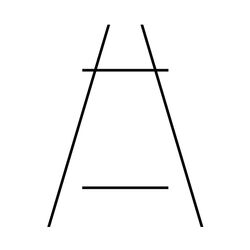Assessment |
Biopsychology |
Comparative |
Cognitive |
Developmental |
Language |
Individual differences |
Personality |
Philosophy |
Social |
Methods |
Statistics |
Clinical |
Educational |
Industrial |
Professional items |
World psychology |
Cognitive Psychology: Attention · Decision making · Learning · Judgement · Memory · Motivation · Perception · Reasoning · Thinking - Cognitive processes Cognition - Outline Index

An example of the Ponzo Illusion. Both horizontal lines are the same size.
The Ponzo illusion is an optical illusion that was first demonstrated by the Italian psychologist Mario Ponzo (1882-1960) in 1913. He suggested that the human mind judges an object's size based on its background. He showed this by drawing two identical lines across a pair of converging lines, similar to railway tracks. The upper line looks longer because we interpret the converging sides according to linear perspective as parallel lines receding into the distance. In this context, we interpret the upper line as though it were farther away, so we see it as longer – a farther object would have to be longer than a nearer one for both to produce retinal images of the same size.
Some researchers believe that the Moon illusion is an example of the Ponzo illusion, with trees and houses playing the role of Ponzo's converging lines. Foreground objects trick our brain into thinking the moon is bigger than it really is.
One of the explanations for Ponzo illusion is the 'Perspective hypothesis', which states that the perspective feature in the figure is obviously produced by the converging lines ordinarily associated with distance, that is, the two oblique lines appear to converge toward the horizon or a vanishing point. Another is the 'Framing effects hypothesis', which says that the difference in the separation or gap of the horizontal lines from the framing coverging lines may determine, or at least contribute to the magnitude of the distortion.
Work by Fujita and the Bloughs suggests that Pigeons can see the illusion too.
See also[]
References & Bibliography[]
Key texts[]
Books[]
Papers[]
- R. W. Brislin (1974)The Ponzo Illusion: Additional Cues, Age, Orientation, and Culture.Journal of Cross-Cultural Psychology 5, 139-161
- Fujita, K., Blough, D. S. & Blough, P. M. (1991) Pigeons see the Ponzo illusion. AnimalLearning & Behavior, 19, 283-293
- Fujita, K., Blough, D.S. & Blough, P.M. (1993). Effects of the inclination of context lines on perception of the Ponzo illusion by pigeons. Animal Learning & Behavior, 21, 29-34